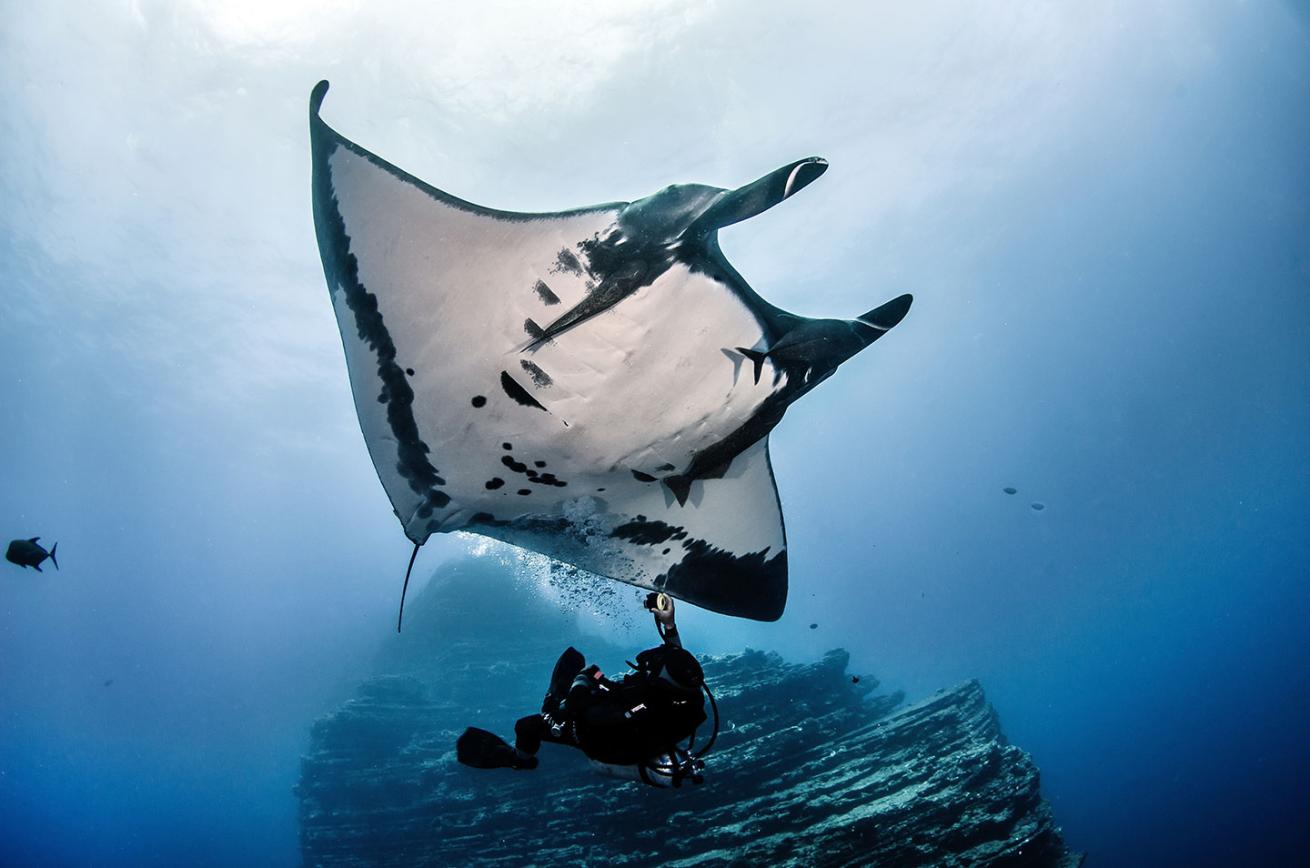Shark and Manta Dives Help Conservation, Studies Show

The giant oceanic manta ray (Manta birostris) is the largest type of ray in the world.
Shutterstock
“I’ll get back in the water when there are a lot of big sharks,” I proclaimed after my first-ever shark dive, and it turns out that many scuba divers feel the same way. Big, powerful sharks and graceful, gentle manta rays are a major draw for divers all over the world. Although divers have long known this, scientists and economists are now providing powerful proof that responsible ecotourism that promotes diving with sharks and rays is not only good for conservation but also for the financial bottom line of many communities.
Scientists estimate that 590,000 of us are now “shark watchers” spending more than $314 million per year directly supporting 10,000 jobs, globally; and that those numbers could double over the next 20 years. That’s a lot of divers willing to pay to see a lot of sharks. Yet, at the same time, sharks are being fished at an estimated rate of between 63 million to 273 million per year for comparatively far less value. In the Red Sea, poaching a medium-to-large shark brings in about $150 via the black market for fins, while similar sharks, alive, could be worth $200,000 in tourist dollars to the same community.
Watch an amazing video of scuba divers rescuing an entangled manta ray.
Another recent study estimates that divers and snorkelers spend more than $73 million annually on manta ray trips, and $140 million on associated tourism in communities from the U.S. to Japan, from Mozambique to Palau and beyond. Meanwhile, mantas, which reproduce even more slowly than many sharks, are killed for their gill rakers to supply a growing yet comparatively far less profitable Asian market, worth only $5 million annually, for a medically unproven “health tonic.”
Why is this so important? Based on an extensive review of the IUCN Red List, the international standard for assessing the status of all species, leading scientists estimate that 33 percent of studied sharks and rays are now threatened with extinction, mostly due to overfishing including many of the same charismatic species we divers want to see most, like great whites, hammerheads and manta rays. But the good news is that the growing popularity of diving with these animals benefits everyone: divers get an epic big-animal experience, dive operators and their local communities benefit economically, and the animals are more valued alive than dead. So, bottom line, you can help save our sharks and manta rays: Go dive with them!

ShutterstockThe giant oceanic manta ray (Manta birostris) is the largest type of ray in the world.
“I’ll get back in the water when there are a lot of big sharks,” I proclaimed after my first-ever shark dive, and it turns out that many scuba divers feel the same way. Big, powerful sharks and graceful, gentle manta rays are a major draw for divers all over the world. Although divers have long known this, scientists and economists are now providing powerful proof that responsible ecotourism that promotes diving with sharks and rays is not only good for conservation but also for the financial bottom line of many communities.
Scientists estimate that 590,000 of us are now “shark watchers” spending more than $314 million per year directly supporting 10,000 jobs, globally; and that those numbers could double over the next 20 years. That’s a lot of divers willing to pay to see a lot of sharks. Yet, at the same time, sharks are being fished at an estimated rate of between 63 million to 273 million per year for comparatively far less value. In the Red Sea, poaching a medium-to-large shark brings in about $150 via the black market for fins, while similar sharks, alive, could be worth $200,000 in tourist dollars to the same community.
Watch an amazing video of scuba divers rescuing an entangled manta ray.
Another recent study estimates that divers and snorkelers spend more than $73 million annually on manta ray trips, and $140 million on associated tourism in communities from the U.S. to Japan, from Mozambique to Palau and beyond. Meanwhile, mantas, which reproduce even more slowly than many sharks, are killed for their gill rakers to supply a growing yet comparatively far less profitable Asian market, worth only $5 million annually, for a medically unproven “health tonic.”
Why is this so important? Based on an extensive review of the IUCN Red List, the international standard for assessing the status of all species, leading scientists estimate that 33 percent of studied sharks and rays are now threatened with extinction, mostly due to overfishing including many of the same charismatic species we divers want to see most, like great whites, hammerheads and manta rays. But the good news is that the growing popularity of diving with these animals benefits everyone: divers get an epic big-animal experience, dive operators and their local communities benefit economically, and the animals are more valued alive than dead. So, bottom line, you can help save our sharks and manta rays: Go dive with them!










